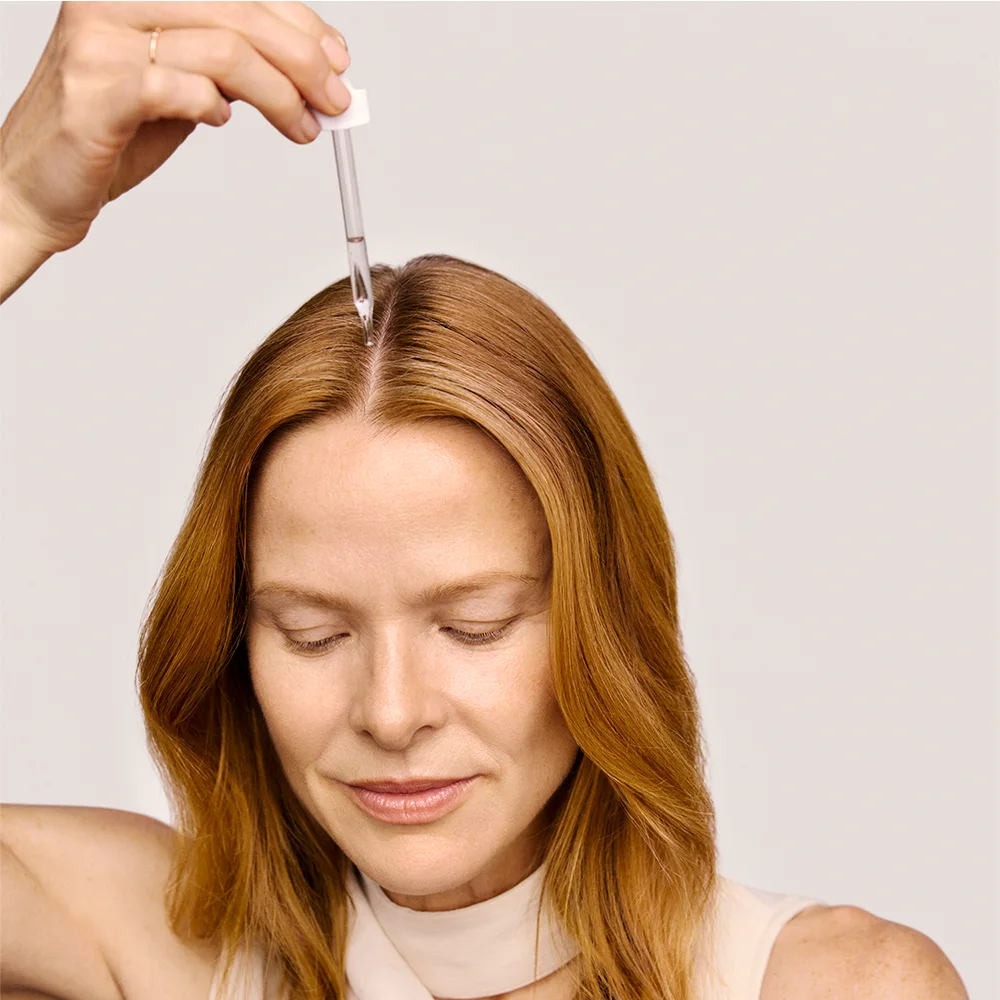Here's what we'll cover
Are you noticing bald spots, or shedding more hair than usual? It may be a sign of hair loss. Hair loss can show up differently in women, depending on the type of hair loss and the cause. Read on to learn about common causes of hair loss in women, treatment options, and what you can do to prevent it.
Types of hair loss in women
Humans shed a lot of hair every day—between 100 to 150 hairs, on average. If you’re losing more than that, you may be experiencing hair loss (Malkud, 2015).
Women often notice hair thinning at the top of the head or along the sides of the hairline. Your part may be growing wider, or you start seeing more of your scalp when you pull your hair back (Herskovitz, 2013).
There are different types of female hair loss, including:
Anagen effluvium gets its name from the affected stage of hair growth. During the anagen (growth) phase, your hair is actively growing. At any given time, about 90% of your hair is in this active growth phase. Anagen effluvium occurs when a medication, like chemotherapy, attacks the hair follicles and causes hair loss (Saleh, 2022).
Telogen effluvium also gets its name from its stage in the hair growth cycle. In the telogen (resting) phase, your hair falls out. While the anagen phase can last anywhere from two to six years, the telogen phase only lasts about three months (Herskovitz, 2013). With telogen effluvium, a significant number of your hairs suddenly shift to the telogen phase, causing the hair to fall out just a few months later (Malkud, 2015).
Androgenic alopecia, also known as female pattern hair loss or baldness, is characterized by progressive hair loss and bald spots in specific areas, such as the top or sides of your head. With this type of hair loss, the hair follicles shrink, and new hairs grow in thinner. Androgenic alopecia is the most common of female hair loss, affecting around one in ten women by age 30 and up to 40% of women in their sixties (Herskovitz, 2013). It’s also the most common cause of male pattern baldness.
Alopecia areata also attacks the hair follicles, but it can cause hair loss anywhere on the body. Hair may fall out in patches, and women may go completely bald on their scalp or their entire body. While androgenic alopecia is a common form of female hair loss often caused by aging, genetics, and hormones, alopecia areata is a rare autoimmune disease that affects up to 2% of people in their lifetimes (Lepe, 2022).
What causes hair loss in women?
Several factors could explain why you’re finding more hair in your brush or seeing more scalp skin in the area where you part your hair.
Lifestyle factors
The way you style and treat your hair can damage your hair follicles. For example, tight ponytails, braids, weaves, and extensions can tug on your hair, leading to traction alopecia (Haskin, 2016).
Your diet can also contribute to hair loss, particularly if you’re not getting enough vitamins or nutrients, or recently lost a lot of weight (Herskovitz, 2013).
Stress or trauma
Women who live under extreme stress or experience a traumatic event may notice telogen effluvium, or sudden hair loss, a few months after the event. The trauma can be emotional or physical, such as giving birth, losing a loved one, losing a job, crash dieting, or undergoing surgery (Herskovitz, 2013; Malkud, 2015).
Medications
Certain medications and supplements may cause hair loss as a side effect. These include oral retinoids (derivatives of vitamin A), birth control pills, and drugs that treat blood pressure, like beta blockers and captopril (Malkud, 2015). Cancer treatment, such as chemotherapy, may also cause sudden hair loss within a few weeks of starting treatment (Saleh, 2022).
Hormonal changes
Hormonal changes can also lead to hair loss in women (Grymowicz, 2020). For example, women who recently gave birth may experience postpartum telogen effluvium (Malkud, 2015).
As women age and enter menopause, their estrogen levels fall. As a result, hair follicles shrink, which can lead to slower hair growth, thinning hair, and hair loss. At the same time, you may notice hair growth in new or unexpected places, like your face (Grymowicz, 2020).
With frontal fibrosing alopecia (FFA), the hair follicles become inflamed and scarred, causing hair loss in the hairline and eyebrows. FFA is more common in postmenopausal women but can affect women of any age (Herskovitz, 2013).
Health conditions
Some medical conditions can cause hair loss in women, including thyroid disorders, anemia, and polycystic ovary syndrome (PCOS) (Malkud, 2015; Herskovitz, 2013). Autoimmune conditions like systemic lupus erythematosus can also cause hair loss or thinning (Malkud, 2015).
Genetics
Some women may be predisposed to female pattern hair loss if it runs in their family (Herskovitz, 2013). Similarly, women with a family history of alopecia areata may be at increased risk of experiencing hair loss (Lepe, 2022).
Other risk factors
Women can experience hair loss at any time, but it’s more common in women who (Grymowicz, 2020; Haskin, 2016; Malkud, 2015; Saleh, 2022):
Are pregnant or have just given birth
Are older than 40
Are going through menopause
Are undergoing chemotherapy
Are taking medications that may cause hair loss
Wear their hair in tight hairstyles
Treat their hair with harsh chemicals
Treating female hair loss
Hair loss treatments often depend on the underlying cause. Sometimes, the hair may grow back on its own. This can happen in cases where the hair loss was induced by stress, or an event such as pregnancy (Malkud, 2015). If chemotherapy caused the hair to fall out, the hair usually grows back once the treatment is complete, although some thinning or hair loss may be permanent (Saleh, 2022; Herskovitz, 2013).
In some cases, simple lifestyle changes may stimulate new hair growth in women. For example, if a restricted diet was causing your hair to fall out, your healthcare provider may recommend changing your diet to include more essential vitamins and nutrients, especially iron (Herskovitz, 2013; Malkud, 2015). Supplements may also be recommended; however, studies have shown biotin is not effective in treating hair loss (van Zuuren, 2016; Malkud, 2015). If hair styling was contributing to your hair loss, a dermatologist may recommend wearing your hair in looser styles, and stopping the use of any chemical treatments or heat styling (Pulickal, 2022).
With female pattern hair loss, a dermatologist can prescribe medication to promote hair growth, such as minoxidil (Rogaine), a topical medication you apply to bald spots (Herskovitz, 2013; van Zuuren, 2016). Topical creams are also prescribed to women with alopecia areata (Lepe, 2022). Other medications that may be prescribed off-label to treat hair loss in women include (Herskovitz, 2013; van Zuuren, 2016):
Anti-androgens like spironolactone
Estrogens
Prostaglandin analogs
Steroids
If you see a healthcare provider about your hair loss, be sure to tell them about your medical history and whether you are currently pregnant or plan to get pregnant. Some hair loss medications are not safe during pregnancy or while breastfeeding (Suchonwanit, 2019).
Dermatologists may also recommend light or laser treatments to treat female pattern baldness (Herskovitz, 2013; Jimenez, 2014). Other options include hair transplant surgery, protein-rich plasma (PRP) injections, and scalp microneedling (Herskovitz, 2013; Zhou, 2021; Gupta, 2022).
Finally, some women may find it helpful to wear a wig or use hair concealer spray to cover up a receding hairline (van Zuuren, 2016). Different hairstyles can also disguise bald spots better than others.
Women's Oral Minoxidil Important Safety Information: Read about serious warnings and safety info.
Finasteride Important Safety Information: Read more about serious warnings and safety info.
How to prevent hair loss in women
Many of the causes of hair loss in women are not necessarily preventable, but you can take certain lifestyle precautions to prevent or minimize hair loss. Try these hair care tips (Pulickal, 2022; Herskovitz, 2013; Malkud, 2015; Malkani, 2020):
Avoid sun exposure on your scalp (e.g., wear hats).
Avoid perms, straightening, and hair extensions.
Eat a well-balanced diet with enough iron, protein, and essential vitamins.
Don’t smoke.
Manage your stress.
Use heat styling less often, including blow-dryers and straightening irons.
Wear your hair in looser braids or hairstyles.
Losing your hair can be a distressing experience, but there are options to get help. The sooner you talk to a health provider, the sooner you can get treatment.
DISCLAIMER
If you have any medical questions or concerns, please talk to your healthcare provider. The articles on Health Guide are underpinned by peer-reviewed research and information drawn from medical societies and governmental agencies. However, they are not a substitute for professional medical advice, diagnosis, or treatment.
References
Grymowicz, M., Rudnicka, E., Podfigurna, A., et al. (2020). Hormonal effects on hair follicles. International Journal of Molecular Sciences , 21 (15), 5342. doi:10.3390/ijms21155342. Retrieved from https://pubmed.ncbi.nlm.nih.gov/32731328/
Gupta, A. K., Quinlan, E. M., Venkataraman, M., et al. (2022). Microneedling for hair loss. Journal of Cosmetic Dermatology , 21 (1), 108–117. doi:10.1111/jocd.14525. Retrieved from https://pubmed.ncbi.nlm.nih.gov/34714971/
Haskin, A. & Aguh, C. (2016). All hairstyles are not created equal: What the dermatologist needs to know about black hairstyling practices and the risk of traction alopecia (TA). Journal of the American Academy of Dermatology , 75 (3), 606–611. doi:10.1016/j.jaad.2016.02.1162. Retrieved from https://pubmed.ncbi.nlm.nih.gov/27114262/
Herskovitz, I. & Tosti, A. (2013). Female pattern hair loss. International Journal of Endocrinology and Metabolism , 11 (4), e9860. doi:10.5812/ijem.9860. Retrieved from https://pubmed.ncbi.nlm.nih.gov/24719635/
Jimenez, J. J., Wikramanayake, T. C., Bergfeld, W., et al. (2014). Efficacy and safety of a low-level laser device in the treatment of male and female pattern hair loss: a multicenter, randomized, sham device-controlled, double-blind study. American Journal of Clinical Dermatology , 15 (2), 115–127. doi:10.1007/s40257-013-0060-6. Retrieved from https://pubmed.ncbi.nlm.nih.gov/24474647/
Lepe, K. & Zito, P. M. (2022). Alopecia areata. StatPearls . Retrieved on Nov. 3, 2022 from https://www.ncbi.nlm.nih.gov/books/NBK537000/
Malkani, R. H., Shirolikar, S. M., Karmakar, S., et al. (2020). Hair styling procedures and hair morphology: A clinico-microscopic comparison study. Indian Dermatology Online Journal , 11 (4), 551–558. doi:10.4103/idoj.IDOJ_452_19. Retrieved from https://pubmed.ncbi.nlm.nih.gov/32832441/
Malkud, S. (2015). Telogen effluvium: A review. Journal of Clinical and Diagnostic Research, 9 (9), WE01–WE3. doi:10.7860/JCDR/2015/15219.6492. Retrieved from https://pubmed.ncbi.nlm.nih.gov/26500992/
Pulickal, J. K. & Kaliyadan, F. (2022). Traction alopecia. StatPearls . Retrieved on Nov. 3, 2022 from https://www.ncbi.nlm.nih.gov/books/NBK470434/
Saleh, D., Nassereddin, A., & Cook, C. (2022). Anagen effluvium. StatPearls . Retrieved on Nov. 3, 2022 from https://www.ncbi.nlm.nih.gov/books/NBK482293/
Suchonwanit, P., Thammarucha, S., & Leerunyakul, K. (2019). Minoxidil and its use in hair disorders: a review. Drug Design, Development and Therapy , 13 , 2777–2786. doi:10.2147/DDDT.S214907. Retrieved from https://pubmed.ncbi.nlm.nih.gov/31496654/
van Zuuren, E. J., Fedorowicz, Z., & Schoones, J. (2016). Interventions for female pattern hair loss. The Cochrane Database of Systematic Reviews , 2016 (5), CD007628. doi:10.1002/14651858.CD007628.pub4. Retrieved from https://pubmed.ncbi.nlm.nih.gov/27225981/
Zhou, S., Qi, F., Gong, Y., et al. (2021). Platelet-rich plasma in female androgenic alopecia: A comprehensive systematic review and meta-analysis. Frontiers in Pharmacology, 12 , 642980. doi:10.3389/fphar.2021.642980. Retrieved from https://pubmed.ncbi.nlm.nih.gov/34140889/












